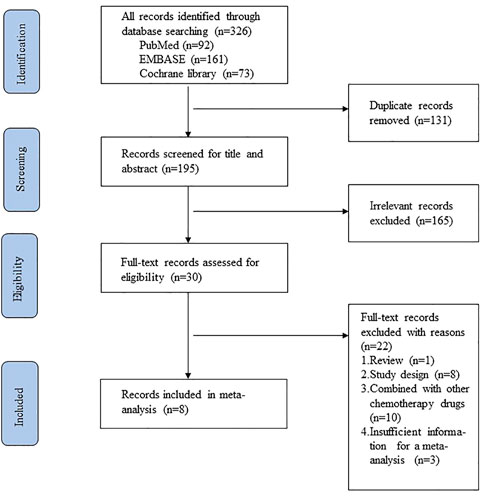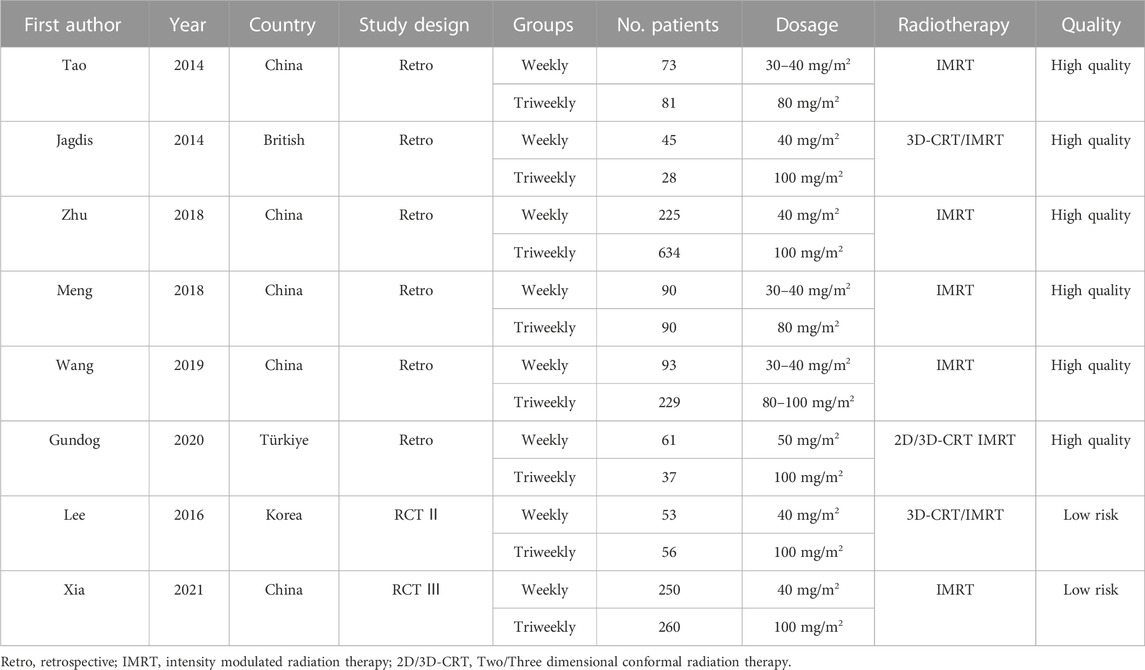- Department of Oncology, Shengjing Hospital of China Medical University, Shenyang, China
Background: Most nasopharyngeal carcinoma cases are diagnosed at an advanced stage due to their hidden anatomical structure and atypical clinical symptoms and often require chemoradiotherapy. Here, we present a systematic review and pooled analysis to synthesize existing research on the efficacy and adverse effects of weekly versus triweekly cisplatin chemotherapy concomitant with radiotherapy for locally advanced nasopharyngeal carcinoma (LANPC).
Methods: We searched the PubMed, Embase, and Cochrane Library databases from inception to 1 September 2021, for relevant original research articles published in English. The literature search and data extraction were done independently by two investigators. We used random-effects models to provide point estimates [95% confidence interval (CI)] of overall response rate (ORR), overall survival (OS), progression-free survival (PFS), locoregional recurrence-free survival (LRFS), distant metastasis-free survival (DMFS) and the incidence rate of adverse effects (AEs) and with subgroup analysis according to each study type. The primary endpoints were ORR, OS, and PFS; LRFS, DMFS, and grade ≥3 acute AEs were secondary endpoints.
Results: In total, 2,305 patients of eight studies were included in this review. We found that patients who were administered cisplatin weekly or triweekly had no differences in ORR, OS, PFS, DMFS, LRFS, severe mucositis, dermatitis, nausea/vomiting or nephrotoxicity. Patients who were administered weekly cisplatin were at a higher risk of hematological toxicity compared with patients who received the chemotherapy triweekly.
Conclusion: Our findings suggest that both regimens could be recommended as the standard of care for the chemoradiotherapy treatment of LANPC, the perceived benefit of lower toxicity with weekly cisplatin could not be established.
1 Introduction
Most nasopharyngeal carcinoma (NPC) cases are diagnosed at an advanced stage due to the unique anatomical position of tumors and varied clinical manifestations (Torre et al., 2015). Patients with locally advanced nasopharyngeal carcinoma (LANPC) are often treated with radiotherapy and adjuvant chemotherapy to reduce local recurrence and distant metastasis (Li et al., 2019; Li et al., 2019). Common chemotherapy agents that demonstrate efficacy against NPC include platinum compounds (cisplatin and carboplatin), fiuorouracil, and taxanes (docetaxel and paclitaxel). Cisplatin-based regimens have been established as the most effective, and a dose of 100 mg/m2 given every 3 weeks is the most common (Tang et al., 2018). However, the majority of patients who undergo chemoradiotherapy will suffer from serious radiotherapy-induced mucosa and skin damage, hematological toxicity, and gastrointestinal reactions (Lee et al., 2010). Adverse effects (AEs) tend to cause patients extreme pain, which leads some patients to renounce their treatments (Chen et al., 2021). Accordingly, minimizing adverse effects during treatment is an important goal for clinical oncologists. In recent years, increasing evidence has indicated that weekly chemotherapy has similar efficacy and lower toxicity than triweekly regimens for many types of cancers (Schuette et al., 2005; Dessai et al., 2016; Tousif et al., 2020). Multiple studies have compared the outcomes of weekly and triweekly cisplatin concurrent chemoradiotherapy (CCRT) in advanced head and neck squamous cell carcinoma (HNSCC) (Espelia et al., 2012; Geiger et al., 2014; Tsan et al., 2012). Most studies have excluded analysis solely of a cohort of patients with nasopharyngeal cancer, as the biology and behavior of this malignancy differ from other HNSCC. A previous meta-analysis was conducted to compare benefits and risks of weekly and triweekly cisplatin schedules across NPC patients during CCRT (Tang et al., 2021). The study concluded that both weekly and triweekly schedules could be recommended to NPC patients. However there were only four retrospective studies eligible in that pooled analysis. Therefore, we performed this pooled analysis which included more retrospective studies and randomized controlled trials (RCTs) to synthesize results from the existing literature to compare the efficacies and adverse effects of the different cisplatin schedules for patients with LANPC.
2 Materials and methods
2.1 Search strategy
This systematic review and pooled analysis were conducted in accordance with the preferred reporting items for systematic reviews and meta-analyses (PRISMA) guidelines. Two authors (XT and QXZ) independently searched for published studies in PubMed, Embase, and the Cochrane Library from inception to 1 September 2021 and used search terms that were chosen in collaboration with an experienced medical librarian. The search key words “weekly,” “3-weekly,” “triweekly,” “cisplatin,” “nasopharyngeal carcinoma,” “radiotherapy,” “chemoradiotherapy,” “chemoradiation,” and “radiation” were used in both “AND” and “OR” combinations.
2.2 Eligibility and exclusion criteria
We included all relevant studies that provided data regarding overall response rate (ORR), overall survival (OS), progression-free survival (PFS), distant metastasis-free survival (DMFS), locoregional recurrence-free survival (LRFS), and AEs in patients with LANPC who underwent definitive chemoradiation with weekly or triweekly cisplatin chemotherapy. The inclusion criteria were as follows: 1) LANPC was diagnosed by histopathological findings; 2) previously untreated and non-distant metastatic cases; 3) patients treated with chemoradiotherapy; 4) a risk ratio (RR) or hazard ratio (HR) with 95% confidence intervals (CIs) was available. Exclusion criteria for the analysis were as follows: 1) The study was a review article, abstract, case report, poster, conference paper, thesis, or book; 2) studies that included fewer than 30 patients; 3) the study was single armed; 4) the study used other chemotherapy drugs; We brought all the searched results from the three electronic data-bases above into EndNote (Thomson Reuters, PA, US). Only publications written in English were included. Publications with duplicate data were excluded. Articles were initially screened by title and abstract, and then full-text articles were assessed to identify eligible studies. Two reviewers (XT and QXZ) independently evaluated all of the included studies. Disagreements about inclusion and exclusion were resolved by discussion between the two authors or by consulting a third senior researcher (ZYZ).
2.3 Data selection, extraction, and quality assessment
Two reviewers independently reviewed the full texts of all relevant research papers. Data were extracted into a designated worksheet and included the following: first authors; country; year of publication; study design type; number of patients; dosage of chemotherapy and radiotherapy; hazard ratios (HR) and 95% CIs for OS, PFS, DMFS, and LRFS; and risk ratios (RR) and 95% CIs for ORR and AEs. Data were extracted independently by two investigators (XT and QXZ), and disagreements were resolved by consensus or through discussion with a third reviewer (ZYZ). The risk of bias of each RCT was assessed according to the Cochrane collaboration network’s bias risk assessment criteria. The risk of bias in each retrospective study was assessed according to the Newcastle-Ottawa scale (NOS), which included the selection process, comparability, and outcome of this study. Studies with the Cochrane collaboration network with low to moderate risk of bias or NOS scores ≥6 were considered high-quality and included in this meta-analysis.
2.4 Data synthesis and statistical analysis
Data were analyzed using STATA (version 12.0, Stata Corporation, College Station, TX, United States). The primary outcomes were ORR, OS, and PFS; the secondary endpoints were LRFS, DMFS, and grade ≥3 AEs. The survival outcomes related to PFS, OS, LRFS, and DMFS were expressed as the HR with a 95% CI while the outcomes related to ORR and AEs were expressed as the RR with a 95% CI. We assessed heterogeneity using the Cochran Q-statistic and the I2 statistic. Estimates with a p-value lower than .05 for the Q-statistic and I2 of 50% or greater were considered to have moderate heterogeneity. As the included studies differed regarding their design and patients’ baselines, pooled analyses were performed using a random-effects model. Subgroup analyses were conducted according to different study types. Additionally, publication bias was assessed using funnel plots and Egger’s and Begg’s tests when n > 5 studies.
3 Results
3.1 Study selection and patient characteristics
According to the PRISMA flow chart, the selection process for eligible research is illustrated in Figure 1. A total of 326 articles were identified by searching the databases, comprising 92 from Pubmed, 161 from Embase, and 73 from Cochrane Library. We excluded 131 duplicate studies. Next, 165 irrelevant studies were excluded upon reviewing the titles and abstracts. The full texts of 121 the 30 remaining studies were reviewed, and eight studies that met the inclusion criteria were ultimately included. Characteristics of the selected studies are summarized in Table 1. Six retrospective studies (Jagdis et al., 2014; Tao et al., 2014; Meng et al., 2018; Zhu et al., 2018; Wang et al., 2019; Gundog et al., 2020) and two RCTs (Lee et al., 2016; Xia et al., 2021) were included in the analysis. The RCTs included one phase II and one phase III clinical trials. All of the eight studies included a total of 2,305 patients with LANPC. Of these, 890 received weekly cisplatin chemotherapy + radiotherapy and 1,415 received triweekly cisplatin chemotherapy + radiotherapy. A total of four studies reported the outcomes of ORR; seven studies reported the outcomes of survival; and eight studies reported the results of AES.
3.2 Risk of bias of included studies
The risk of bias of the two RCTs in our studies was assessed according to the Cochrane collaboration network’s bias risk assessment criteria as having a low risk of bias (Table 1). The risk of bias of six retrospective studies was assessed with NOS scores ≥6 which were generally considered high quality.
3.3 Clinical efficacy
Two retrospective study and two RCTs reported data on ORR. The two retrospective studies included 134 patients in the weekly group and 118 patients in the triweekly group, while the two RCTs included 303 patients in the weekly group and 316 patients in the triweekly group. As the included studies differed regarding the study design and patient baselines, a random-effects model was used. The pooled RR indicated no difference in ORR between patients who were administered cisplatin weekly or triweekly in the retrospective studies (RR: .98; 95% CI: .94–1.03, p = .509) 145 and the RCTs (RR: 1.00; 95% CI: .99–1.02; p = .531; I2 = 0%) nor in all studies (RR: 1.00; 95% CI 146 .99–1.02; p = .676; I2 = 0%) (Figure 2A).
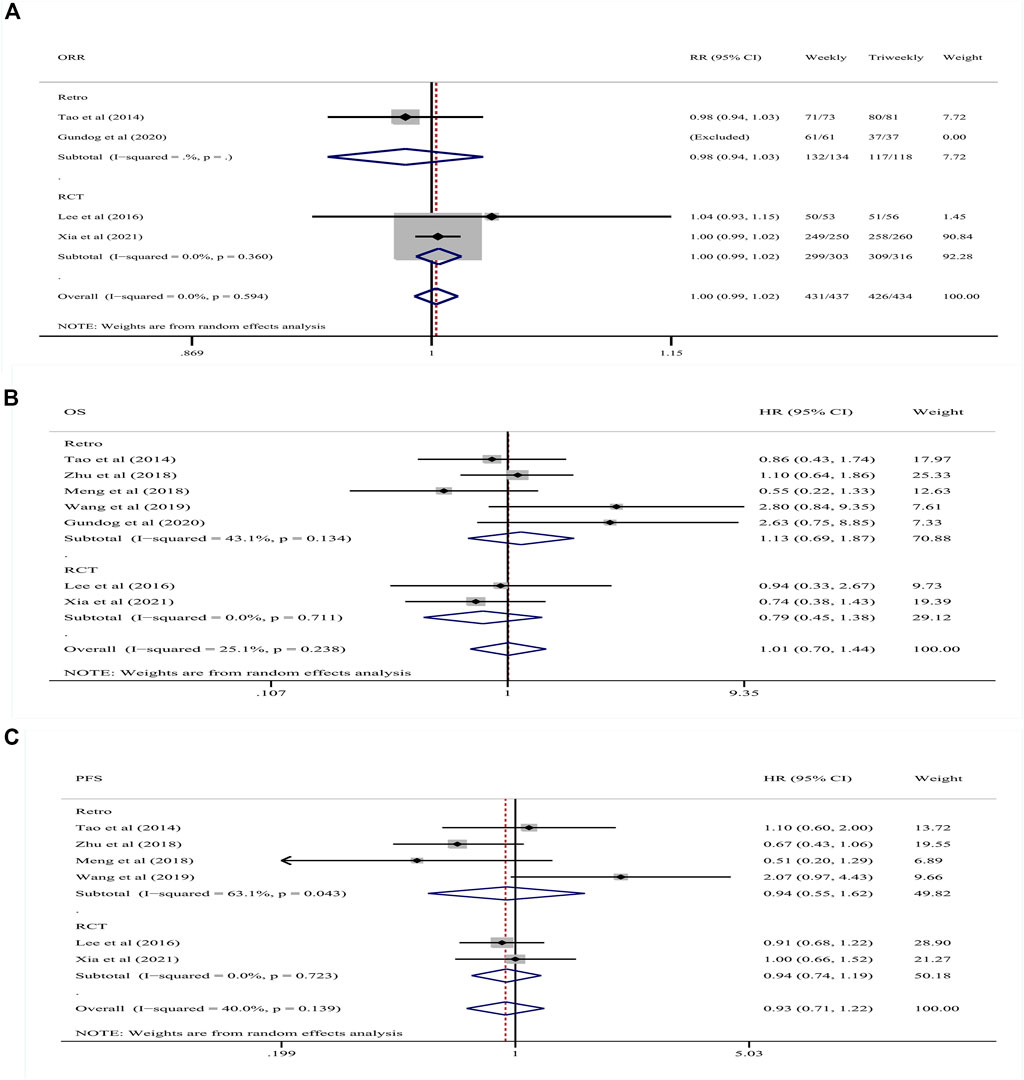
FIGURE 2. Forest plots of the comparison of (A) ORR; (B) OS, and (C) PFS between patients administered cisplatin weekly or triweekly. ORR, objective response rate; OS, overall survival; PFS, progression-free survival.
3.4 Survival
3.4.1 OS and PFS
Five retrospective studies and two RCTs reported data on OS and PFS. The five retrospective studies included 542 patients in the weekly group and 1,071 patients in the triweekly group while the two RCTs included 303 patients in the weekly group and 316 patients in the triweekly group. A random-effects model was used because of the different types of studies included. The pooled HR of OS in all studies was 1.01 (95% CI .70–1.44, p = .976; I2 = 25.1%), which indicated no difference in OS between the weekly and triweekly groups. In subgroup analyses according to the different study designs, the pooled HR was 1.13 (95% CI .69–1.87, p = .621; I2 = 43.1%) in the retrospective studies and .79 (95% CI .45–1.38, p = .412; I2 = 0%) in the RCTs and did not differ between the cisplatin treatment regimens. The pooled HR in all studies of PFS was .93 (95% CI .71–1.22, p = .616; I2 = 40%), which indicated no difference in PFS between patients treated weekly versus triweekly. In subgroup analyses according to different study designs, the pooled HR was .94 (95% CI .55–1.22, p = .823; I2 = 63.1%) in the retrospective studies and .94 (95% CI .74–1.19, p = .613; I2 = 0%) in the RCTs, and were not different between the treatment regimens regardless of the study designs (Figures 2B, C).
3.4.2 DMFS and LRFS
Five retrospective studies and one RCT reported data on DMFS and LRFS. The five retrospective studies included 542 patients in the weekly group and 1,071 patients in the triweekly group while the RCT included 250 patients in the weekly group and 260 patients in the triweekly group. A random-effects model was used given that different types of studies were analyzed. The pooled HR of DMFS in all studies was .83 (95% CI .51–1.34; p = .442; I2 = 36.8%), which indicated that there was no difference in DMFS between the cisplatin regiments. In subgroup analyses according to the different types of study design, the pooled HR was .80 (95% CI .41–1.55; p = .504; I2 = 47.4%) in the retrospective studies and .94 (95% CI 0. 54–1.64; p = .827) in the RCT, which indicated no difference between weekly versus triweekly treatment. The pooled HR of LRFS in all studies was 1.18 (95% CI .79–1.77; p = .414; I2 = 15.7%), which indicated no difference in LRFS between the treatment groups. In subgroup analyses according to the different study designs, the pooled HR was 1.23 (95% CI .69–2.18; p = .478; I2 = 32.5%) in the retrospective studies and 1.14 (95% CI .61–2.13; p = .681) in the RCT and did not differ between the two treatment groups, regardless of the study type (Figure 3).
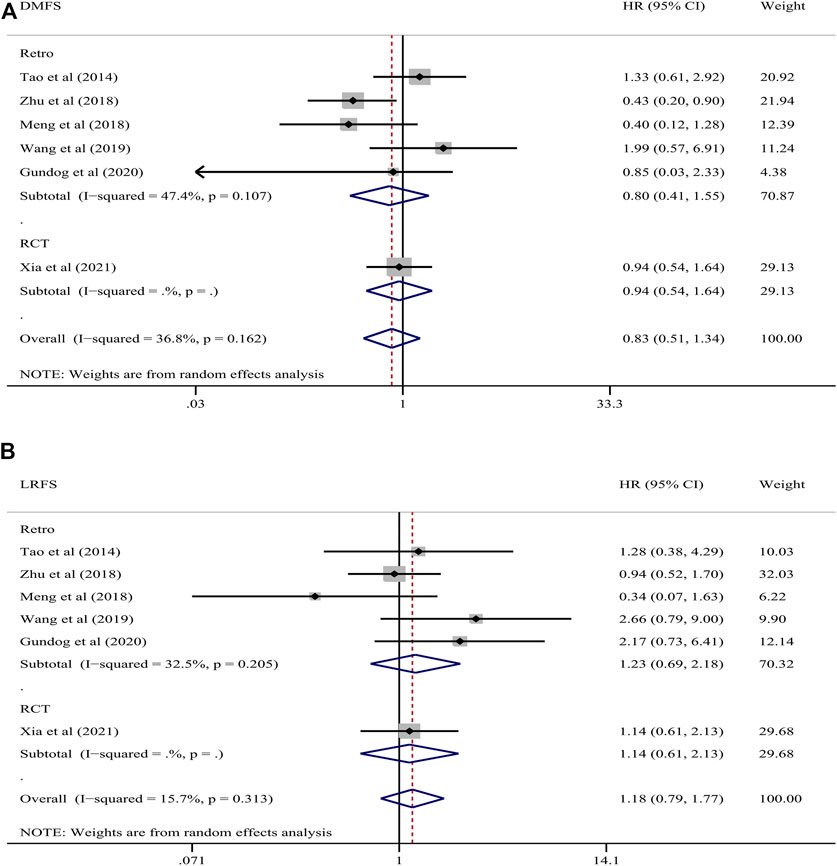
FIGURE 3. Forest plots of the comparison of (A) DMFS and (B) LRFS between patients administered cisplatin weekly or triweekly. DMFS, distant metastasis-free survival; LRFS, locoregional recurrence-free survival.
3.5 Adverse reactions
AEs (grade ≥ 3) were used to evaluate the safety of weekly and triweekly cisplatin chemotherapy concurrent with radiotherapy in treatment of LANPC. Five retrospective studies and two RCTs reported data on hematological AEs, while six retrospective studies and two RCTs provided data on non-hematological AEs. The pooled RRs of severe AEs (grade ≥ 3) are displayed in Figure 4 and Figure 5.
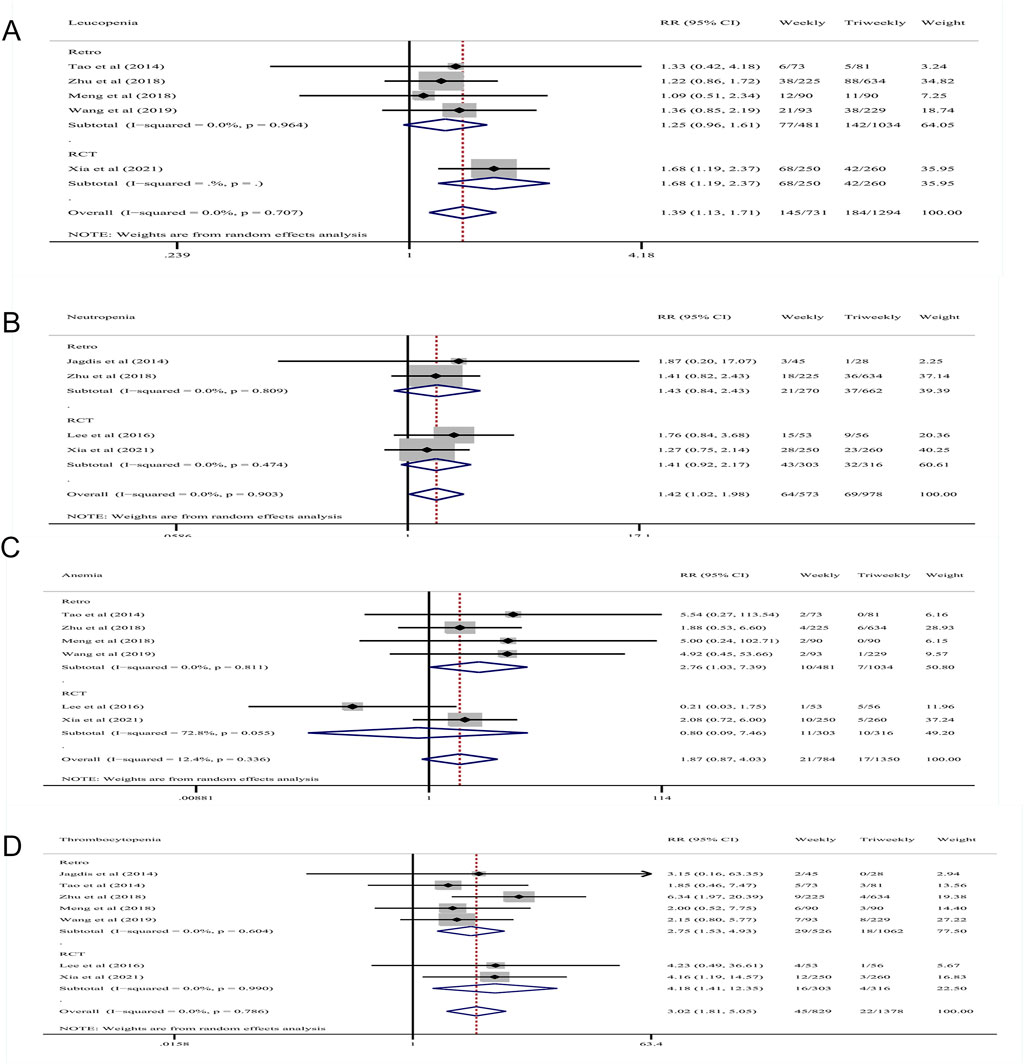
FIGURE 4. Forest plots of the RRs of Severe Hematological AEs (A) grade 3–4 leukopenia; (B) grade 3–4 neutropenia; (C) grade 3–4 anemia; (D) grade 3–4 thrombocytopenia. RR, risk ratios; AEs, adverse effects.
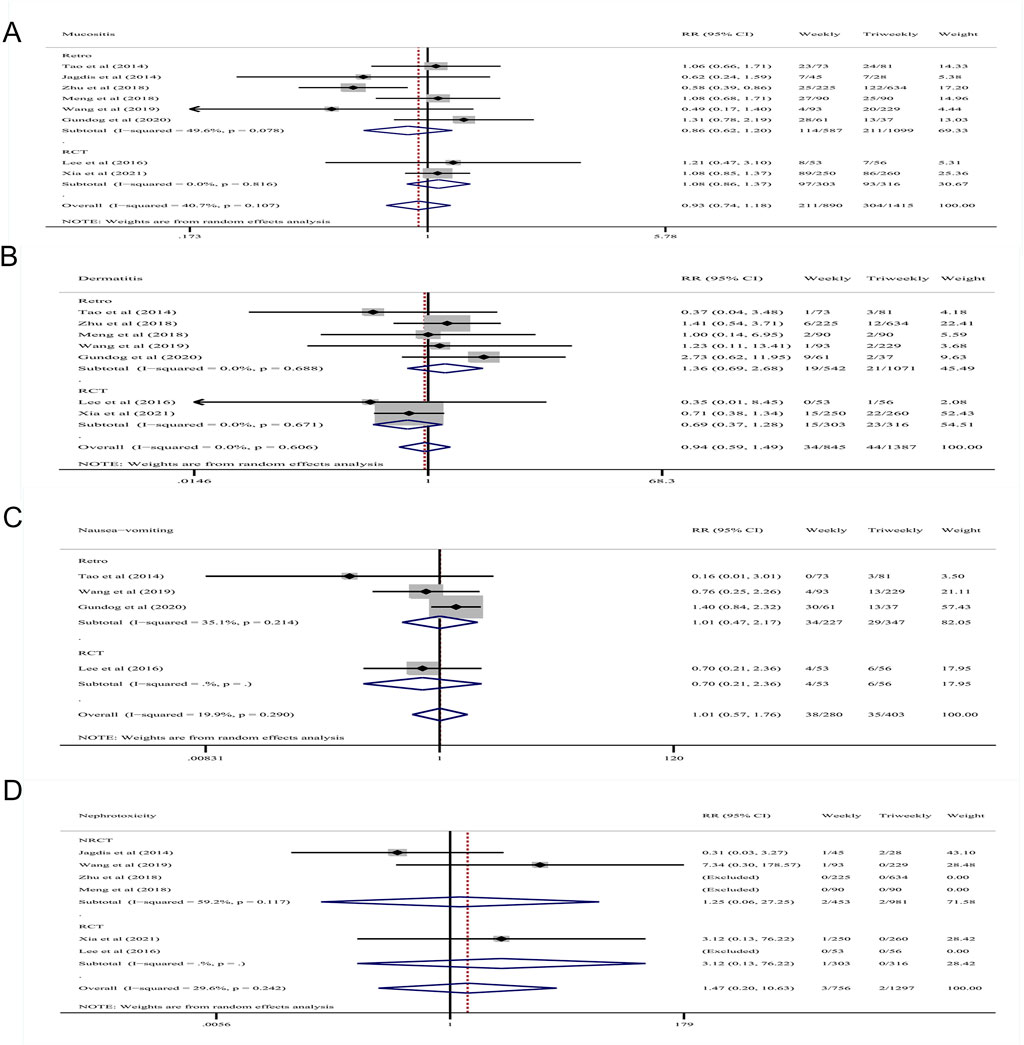
FIGURE 5. Forest plots of the RRs of Severe Non-hematological AEs (A) grade 3–4 mucositis; (B) grade 3–4 dermatitis; (C) grade 3–4 nausea/vomiting; (D) grade 3–4 nephrotoxicity. RR, risk ratios; AEs, adverse effects.
3.5.1 Severe hematological AEs
Five retrospective studies including 526 patients in the weekly group and 1,062 patients in the triweekly group, as well as two RCTs including 303 patients in the weekly group and 316 patients in the triweekly group reported data on hematological AEs. The pooled RR of grade ≥ 3 thrombocytopenia indicated that patients treated weekly were at a higher risk in both the retrospective studies (RR: 2.75; 95% CI: 1.53–4.93; p = .001; I2 = 0%) and RCTs (RR: 4.18; 95% CI: 1.41–12.35; p = .010; I2 = 0%), as well as in all studies (RR: 3.02; 95% CI 1.81–5.05; p = .000; I2 = 0%). The pooled RR of grade ≥ 3 leukopenia indicated that weekly treatment was associated with greater risk in RCTs (RR: 1.68; 95% CI: 1.19–2.37; p = .003) and in all studies (RR: 1.39; 95% CI 1.13–1.71; p = .002; I2 = 0%). The pooled RR of grade ≥ 3 neutropenia indicated that patients who had been treated with cisplatin weekly had a higher risk in all of the studies (RR: 1.42; 95% CI 1.02–1.98; p = .038; I2 = 0%). The pooled RR of grade ≥ 3 anemia indicated that patients who had been treated weekly had a higher risk in retrospective studies (RR: 2.76; 95% CI 1.03–7.39; p = .044; I2 = 0%) (Figure 4).
3.5.2 Severe non-hematological AEs
The most common non-hematological AEs were mucositis, dermatitis, nausea/vomiting and nephrotoxicity. Six retrospective studies, including 587 patients in the weekly group and 1,099 patients in the triweekly group, while two RCTs including 303 patients in the weekly group and 316 patients in the triweekly group reported data on non-hematological AEs. The pooled RRs for grade ≥ 3 mucositis (RR = .93, 95% CI .74–1.18; p = .575; I2 = 40.7%), dermatitis (RR = .94, 95% CI .59–1.49; p = .790; I2 = 0%), nausea/vomiting (RR = 1.01, 95% CI .57–1.76; p = .980; I2 = 19.9%), and nephrotoxicity (RR = 1.47, 95% CI .20–10.63; p = .700; I2 = 29.6%) indicated no differences in these AEs between patients treated with either cisplatin regimen.
In further subgroup analysis according to the study type, pooled RRs of grade ≥ 3 mucositis, dermatitis, nausea/vomiting and nephrotoxicity also indicated no differences in these AEs between the treatment groups regardless of the study type (Figure 5).
3.6 Publication bias
Begg’s and Egger’s tests were conducted to assess the publication biases among survival studies. The results of the OS tests were z = .90 (p = .368) and t = 1.15 (p = .301); the results of the PFS tests were z = .38 (p = .707) and t = .28 (p = .797); the results of the DMFS tests were z = .38 (p = .707) and t = .01 (p = .994); the results of the LRFS tests were z = .38 (p = .707) and t = .31 (p = .772). Thus, there was no evidence of publication bias in the meta-analyses of OS, PFS, DMFS, nor LRFS. A funnel plot of Begg’s test is presented in Figure 6.
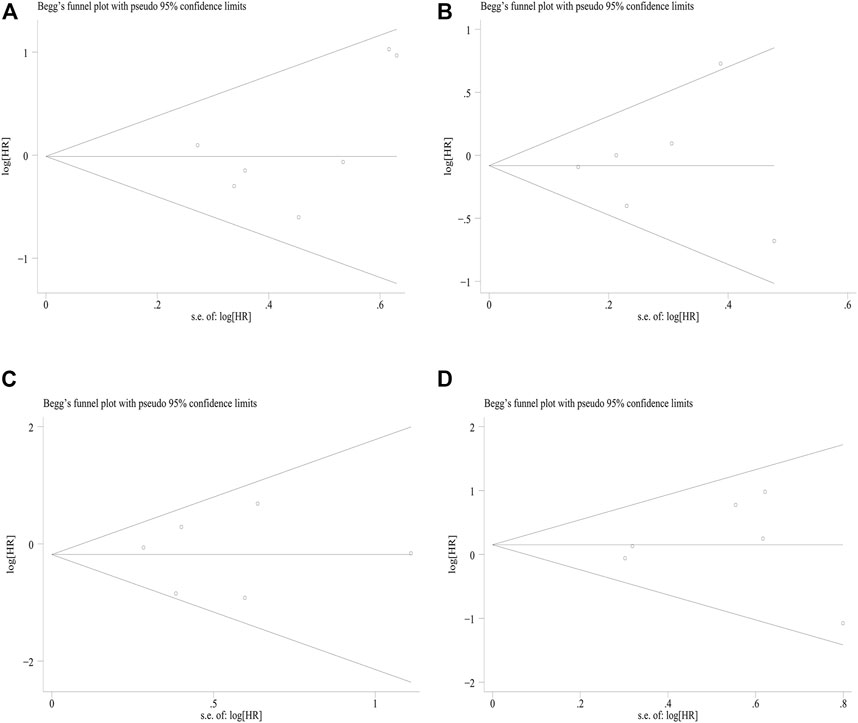
FIGURE 6. Publication bias assessed by funnel plot of (A) OS; (B) PFS; (C) DMFS; (D) LRFS. OS, overall survival; PFS, progression-free survival; DMFS, distant metastasis-free survival; LRFS, locoregional recurrence-free survival.
4 Discussion
This study analyzed the existing research results concerning weekly and triweekly cisplatin regimens concomitant with radiotherapy in patients with LANPC. In the pooled analyses, ORR, OS, PFS, DMFS, and LRFS were similar in both arms. Severe mucositis, dermatitis, nausea/vomiting and nephrotoxicity were similar in both arms. However, patients in the weekly group had an increased risks of grades ≥3 hematological toxicity.
Chemoradiotherapy is the standard treatment for LANPC (Chan et al., 2005). A large number of clinical studies have confirmed the role of chemoradiotherapy in improving both the local control rate of tumors and causing an improvement in overall survival (Chitapanarux et al., 2007; Wu et al., 2013; Blanchard et al., 2015). Synchronous chemoradiotherapy has the following advantages: 1) a synergistic effect, as chemotherapy drugs can improve the sensitivity of tumor cells to radiotherapy, and radiotherapy can also enhance the cytotoxicity of chemotherapy drugs; 2) in theory, chemotherapy can also eliminate small occult metastases and reduce the rate of distant metastasis.
Among all chemotherapy drugs used with radiation therapy for LANPC, cisplatin is the most common (Li et al., 2019). However, chemoradiation is associated with more AEs, which leads to lower compliance rates among patients compared with those who receive radiotherapy only (Lee et al., 2010; Tang et al., 2018; Jiang et al., 2019). One major challenge faced by clinicians is how to reduce the adverse reactions in patients undergoing chemoradiotherapy while ensuring the maximum possible curative effects. Previous studies have shown that weekly cisplatin has good anti-tumor efficacy and is welltolerized in esophageal squamous cell carcinoma, ovarian cancer, and other malignant tumors (Verborg et al., 2008; Caro et al., 2016; Mazzola et al., 2017). The high toxicity of cisplatin led to the assumption that a moderate dose given weekly may be desirable. Studies on the pharmacokinetics of cisplatin have shown the possible superiority of a weekly schedule, which can provide a radiosensitizing effect and reduce toxicity without compromising efficacy (Kurihara et al., 1996; Boulikas et al., 2003).
Studies on weekly and triweekly cisplatin regimens of chemotherapy coinciding with radiation have been reported on HNSCC (Uygun et al., 2009; Kose et al., 2011; Szturz et al., 2017). However, most of them excluded population of nasopharyngeal cancer, there is little known about the comparative efficacies of these treatment regimens for nasopharyngeal carcinoma, which was the focus of our study. However, there is a paucity of data from RCTs due to the low incidence of nasopharyngeal cancer.
In our study, only two qualified RCTs were included, and the remaining six were NRCTs. Well-designed NRCTs are not necessarily more biased than RCTs, as NRCTs often have larger sample sizes and establish more reliable evidence of real world. The six retrospective studies included had sufficient sample sizes, and the literature quality was evaluated to meet the NOS standard. Additionally, Begg’s and Egger’s tests found no evidence of publication bias in the studies. However, in the retrospective studies the chemotherapy choice and assessment of disease progression were decided by physicians, which increased the risk of bias. Thus, pooled analyses were performed using a more conservative random-effects model. In the combined analysis of the final data, we combined the data of two RCTs, six retrospective studies, and all the studies. The results for ORR, survival, and AEs were essentially the same, regardless of the study design type, and there were no significantly different results between the different study types. Therefore, our study is of certain clinical significance.
In our study, the combined analysis of the pooled RRs of ORR, OS, PFS, DMFS, and LRFS were similar in weekly and triweekly groups. The similar clinical efficacy of this two different dosing regimens may have resulted from several reasons. First, cisplatin is chemotherapeutic drug that exert its anticancer effect by causing cross-linking of DNA leading to inhibition of its synthesis and induction of apoptosis. It has been suggested that a cumulative dose of 200 mg/m2 needs to be reached for a therapeutic benefit in cisplatin studies (Geeta et al., 2006). In our study, the cumulative doses of cisplatin in patients treated weekly or triweekly were nearly the same (Table 2), and this possibly contributed to the similarities in efficacy and survival. Second, NPC is a malignant tumor that is highly sensitive to radiotherapy. In recent years, radiotherapy equipment and technology are continuously improving, and intensity modulated radiotherapy (IMRT) has been widely used in the treatment of NPC. Compared with two-dimensional therapy, IMRT has a better dose distribution and can improve the local regional control rate. Better local control rates may improve OS. In most of our included studies, concurrent radiotherapy used IMRT, and we believe that the use of this technique played a significant role in the treatment effect of patients in the two groups. Finally, although pooled analyses were performed using a more conservative random-effects model, a selection bias of the included retrospective studies remained, in which patients with high T and N stage were likely to be assigned in triweekly group (Jagdis et al., 2014; Zhu et al., 2018; Wang et al., 2019; Gundog et al., 2020).
When we evaluated the efficiency and safety of the two regimens, it was necessary to take into consideration the most common AEs. In the case of similar treatment results, adverse reactions are more concerning for both clinicians and patients. One of the main reasons of shifting from a triweekly to weekly schedule is to reduce adverse reactions. In our study, the weekly group was at a higher risk of severe hematological toxicity especially of thrombocytopenia and leukopenia. This may be explained by the selection bias of retrospective studies, in which those who had older age, (Jagdis et al., 2014; Tao et al., 2014; Meng et al., 2018; Zhu et al., 2018; Wang et al., 2019; Gundog et al., 2020) and poor physical condition (Jagdis et al., 2014; Zhu et al., 2018) were likely to be administered weekly cisplatin. These patients are less tolerant of chemoradiotherapy and have a higher incidence of adverse reactions. Regarding non-hematological AEs, the pooled RRs for grade ≥ 3 mucositis, dermatitis in our results indicated no differences between patients treated with either cisplatin regimen. This may have been due to the included studies using IMRT as the concurrent radiotherapy, which can better protect the surrounding normal tissue and organs. Therefore, more RCTs with larger sample size are needed to confirm these results. Triweekly regimen can be confidently adopted without compromising the outcomes and toxicity profiles until the release of more clinical trials with larger sample size and longer follow-up durations. Our results may provide clinical treatment guidelines in most situations and useful information for the design of future clinical studies. Several limitations of our study should be noted. The major limitation of this systematic analysis is the inclusion of only two RCTs, while the remaining six studies were NRCTs due to the low incidence of LANPC. As NRCT studies may have a selection bias, a large number of multicenter RCTs with larger sample sizes should be conducted to confirm the efficacies of each therapeutic approach and AEs. Second, there was moderately heterogeneity in several comparisons (PFS, AEs), which would have an impact on the stability of these results. Third, we only considered high-quality articles published in English, which may have introduced a language bias.
5 Conclusion
This study found both weekly and triweekly cisplatin regimens have similar clinical efficacies in ORR, OS, PFS, DMFS, and LRFS for LANPC. Acute treatment-related toxicities were also similar, with the exception of hematological toxicity favoring the triweekly regimen. While both regimens could be recommended as the standard of care, the perceived benefit of lower toxicity with weekly cisplatin could not be established.
Data availability statement
The original contributions presented in the study are included in the article/supplementary material, further inquiries can be directed to the corresponding author.
Author contributions
XT and ZZ designed the search strategy; XT and QZ conducted the search of the studies; XT and QZ screened the studies; ZZ evaluated the studies; XT and QZ conducted the statistical analysis; XT and ZZ wrote the article. All authors read and approved the final manuscript.
Funding
The study was funded by the Medical Science Research Fund (No. YWJKJJHKYJJ-F2058A).
Conflict of interest
The authors declare that the research was conducted in the absence of any commercial or financial relationships that could be construed as a potential conflict of interest.
Publisher’s note
All claims expressed in this article are solely those of the authors and do not necessarily represent those of their affiliated organizations, or those of the publisher, the editors and the reviewers. Any product that may be evaluated in this article, or claim that may be made by its manufacturer, is not guaranteed or endorsed by the publisher.
References
Blanchard, P., Lee, A., Marguet, S., Leclercq, J., Ng, W. T., Ma, J., et al. (2015). Chemotherapy and radiotherapy in nasopharyngeal carcinoma: An update of the MAC-NPC meta-analysis. Lancet Oncol. 16, 645–655. doi:10.1016/S1470-2045(15)70126-9
Boulikas, T., and Vougiouka, M. (2003). Cisplatin and platinum drugs at the molecular level. (Review). Oncol. Re 10, 1663–1682. doi:10.3892/OR.10.6.1663
Caro, M., Font, A., Comas, S., Viciano, M., Remon, J., Céliz, P., et al. (2016). Preoperative low-dose weekly cisplatin and continuous infusion fluorouracil plus hyperfractionated radiotherapy in stage II-III esophageal carcinoma. Clin. Transl. Oncol. 18, 1106–1113. doi:10.1007/s12094-016-1488-y
Chan, A. T., Leung, S. F., Ngan, R. K., Teo, P. M., Lau, W. H., Kwan, W. H., et al. (2005). Overall survival after concurrent cisplatin-radiotherapy comparedwith radiotherapy alone in locoregionally advanced nasopharyngeal carcinoma. J. Natl. Cancer Inst. 97, 536–539. doi:10.1093/jnci/dji084
Chen, Y. P., Liu, X., Zhou, Q., Yang, K. Y., Jin, F., Zhu, X. D., et al. (2021). Metronomic capecitabine as adjuvant therapy in locoregionally advanced nasopharyngeal carcinoma: A multicentre, open-label, parallel-group, randomised, controlled, phase 3 trial. Lancet 398, 303–313. doi:10.1016/S0140-6736(21)01123-5
Chitapanarux, I., Lorvidhaya, V., Kamnerdsupaphon, P., Sumitsawan, Y., Tharavichitkul, E., Sukthomya, V., et al. (2007). Chemoradiation comparing cisplatin versus carboplatin in locally advanced nasopharyngeal cancer: Randomised, non-inferiority, open trial. Eur. J. Cancer 43, 1399–1406. doi:10.1016/j.ejca.2007.03.022
Dessai, S. B., Chakraborty, S., Babu, T., Nayanar, S., Bhattacharjee, A., Jones, J., et al. (2016)). Tolerance of weekly paclitaxel and carboplatin as neoadjuvant chemotherapy in advanced ovarian cancer patients who are unlikely to tolerate 3 weekly paclitaxel and carboplatin. Indian J. Cancer 53, 280–283. doi:10.4103/0019-509X.197742
Espelia, V., Zuccaa, E., Ghielminia, M., Giannini, O., Salatino, A., Martucci, F., et al. (2012). Weekly and 3-weekly cisplatin concurrent with intensity-modulatedradiotherapy in locally advanced head and neck squamous cell cancer. Oral Oncol. 48, 266–271. doi:10.1016/j.oraloncology.2011.10.005
Geeta, S. N., Padmanabhan, T. K., Samuel, J., Pavithran, K., Iyer, S., et al. (2006). Comparison of acute toxicities of two chemotherapy schedules for head and neck cancers. J. cancer Res. Ther. 2, 100–104. doi:10.4103/0973-1482.27584
Geiger, J. L., Lazim, A. F., Walsh, F. J., Foote, R., Moore, E. J., Okuno, S. H., et al. (2014). Adjuvant chemoradiation therapy with high-dose versus weekly cisplatin for resected, locally-advanced HPV/p16-positiveand negative head and neck squamous cell carcinoma. Oral Oncol. 50, 311–318. doi:10.1016/j.oraloncology.2014.01.001
Gundog, M., Basaran, H., Bozkurt, O., and Eroglu, C. (2020). A comparison of cisplatin cumulative dose and cisplatin schedule in patients treated with concurrent chemo-radiotherapy in nasopharyngeal carcinoma. Braz J. Otorhinolaryngol. 86, 676–686. doi:10.1016/j.bjorl.2019.04.008
Jagdis, A., Laskin, J., Hao, D., Hay, J., Wu, J., and Ho, C. (2014). Dose delivery analysis of weekly versus 3-weekly cisplatin concurrent with radiation therapy for locally advanced nasopharyngeal carcinoma (NPC). Am. J. Clin. Oncol. 37, 63–69. doi:10.1097/COC.0b013e31826b9b1a
Jiang, C., Wang, H., Xia, C., Dong, Q., Chen, E., Qiu, Y., et al. (2019). A randomized, double-blind, placebo-controlled trial of probiotics to reduce the severity of oral mucositis induced by chemoradiotherapy for patients with nasopharyngeal carcinoma. Cancer 125, 1081–1090. doi:10.1002/cncr.31907
Kose, F., Besen, A., Sumbul, T., Sezer, A., Karadeniz, C., Disel, U., et al. (2011). Weekly cisplatin versus standard three-weekly cisplatin in concurrent chemoradiotherapy of head and neck cancer: The baskent university experience. Asian Pac. J. Cancer Prev. 12, 1185–1188. doi:10.1200/jco.2011.29.15_suppl.e16001
Kurihara, N., Kubota, T., Hoshiya, Y., Otani, Y., Ando, N., Kumai, K., et al. (1996). Pharmacokinetics of cis-diamminedichloroplatinum (II) given as low-dose and high-dose infusions. J. Surg. Oncol. 62, 135–138. doi:10.1002/(SICI)1096-9098(199606)62:2<135::AID-JSO10>3.0.CO;2-7
Lee, A. W., Tung, S. Y., Chua, D. T., Ngan, R. K. C., Chappell, R., Tung, R., et al. (2010). Randomized trial of radiotherapy plus concurrent-adjuvant chemotherapy vs radiotherapy alone for regionally advanced nasopharyngeal carcinoma. J. Natl. Cancer Inst. 102, 1188–1198. doi:10.1093/jnci/djq258
Lee, J. Y., Sun, J. M., Oh, D. R., Lim, S. H., Goo, J., Lee, S. H., et al. (2016). Comparison of weekly versus triweekly cisplatin delivered concurrently with radiation therapy in patients with locally advanced nasopharyngeal cancer: A multicenter randomized phase II trial (KCSG-HN10-02). Radiotherapy Oncol. 118, 244–250. doi:10.1016/j.radonc.2015.11.030
Li, W. F., Chen, N. Y., Zhang, N., Hu, G. Q., Xie, F. Y., Sun, Y., et al. (2019a). Concurrent chemoradiotherapy with/without induction chemotherapy in locoregionally advanced nasopharyngeal carcinoma: Long-term results of phase 3 randomized controlled trial. Int. J. Cancer 145, 295–305. doi:10.1002/ijc.32099
Li, X. Y., Chen, Q. Y., Sun, X. S., Liu, S. L., Yan, J. J., Guo, S. S., et al. (2019b). Ten-year outcomes of survival and toxicity for a phase III randomised trial of concurrent chemoradiotherapy versus radiotherapy alone in stage II nasopharyngeal carcinoma. Eur. J. Cancer 110, 24–31. doi:10.1016/j.ejca.2018.10.020
Mazzola, R., Ricchetti, F., Fiorentino, A., Levra, N. G., Fersino, S., Paola, G. D., et al. (2017). Weekly cisplatin and volumetric-modulated arc therapy with simultaneous integrated boost for radical treatment of advanced cervical cancer in elderly patients: Feasibility and clinical preliminary results. Technol. Cancer Res. Treat. 16, 310–315. doi:10.1177/1533034616655055
Meng, D. F., Sun, R., Peng, L. X., Huang, Y. S., Yang, Q., Luo, D. H., et al. (2018). A comparison of weekly versus 3-weekly cisplatin during concurrent chemoradiotherapy for locoregionally advanced nasopharyngeal carcinoma using intensity modulated radiation therapy: A matched study. J. Cancer 9, 92–99. doi:10.7150/jca.21357
Schuette, W., Nagel, S., Blankenburg, T., Lautenschlaeger, C., Hans, K., Schmidt, E., et al. (2005). Phase III study of second-line chemotherapy for advanced non-small-cell lung cancer with weekly compared with 3-weekly docetaxel. J. Clin. Oncol. 23, 8389–8395. doi:10.1200/JCO.2005.02.3739
Szturz, P., Wouters, K., Kiyota, N., Tahara, M., Prabhash, K., Noronha, V., et al. (2017). Weekly low-dose versus three-weekly high-dose cisplatin for concurrent chemoradiation in locoregionally advanced non-nasopharyngeal head and neck cancer: A systematic review and meta-analysis of aggregate data. Oncologist 22, 1056–1066. doi:10.1634/theoncologist.2017-0015
Tang, J., Zou, G. R., Li, X. W., Su, Z., Cao, X. L., and Wang, B. C. (2021). Weekly versus triweekly cisplatin-based concurrent chemoradiotherapy for nasopharyngeal carcinoma: A systematic review and pooled analysis. J. Cancer 12, 6209–6215. doi:10.7150/jca.62188
Tang, L. Q., Chen, D. P., Guo, L., Mo, H. Y., Huang, Y., Guo, S. S., et al. (2018). Concurrent chemoradiotherapy with nedaplatin versus cisplatin in stage II-IVB nasopharyngeal carcinoma: An open-label, non-inferiority, randomised phase 3 trial. Lancet Oncol. 19, 461–473. doi:10.1016/S1470-2045(18)30104-9
Tao, C. J., Lin, L., Zhou, G. Q., Tang, L. L., Chen, L., Mao, Y. P., et al. (2014). Comparison of long-term survival and toxicity of cisplatin delivered weekly versus every three weeks concurrently with intensity-modulated radiotherapy in nasopharyngeal carcinoma. PLoS One 9, e110765. doi:10.1371/journal.pone.0110765
Torre, L. A., Bray, F., Siegel, R. L., Ferlay, J., Lortet-Tieulent, J., and Jemal, A. (2015). Global cancer statistics, 2012. CA Cancer J. Clin. 65, 87–108. doi:10.3322/caac.21262
Tousif, D., Sarathy, V., Kumar, R., and Naik, R. (2020). Randomized controlled study comparing efficacy and toxicity of weekly vs. 3-weekly induction chemotherapy in locally advanced head and neck squamous cell carcinoma. Front. Oncol. 10, 1284. doi:10.3389/fonc.2020.01284
Tsan, D. L., Lin, C. Y., Kang, C. J., Huang, S. F., Fan, K. H., Liao, C. T., et al. (2012). The comparison between weekly and three-weekly cisplatin delivered concurrently with radiotherapy for patients with postoperative high-risk squamous cell carcinoma of the oral cavity. Radiat. Oncol. 7, 215. doi:10.1186/1748-717X-7-215
Uygun, K., Bilici, A., Karagol, H., Caloglu, M., Cicin, I., Aksu, G., et al. (2009). The comparison of weekly and three-weekly cisplatin chemotherapy concurrent with radiotherapy in patients with previously untreated inoperable non-metastatic squamous cell carcinoma of the head and neck. Cancer Chemother. Pharmacol. 64, 601–605. doi:10.1007/s00280-008-0911-7
Verborg, W. A., Campbell, L. R., Highley, M. S., and Rankin, E. M. (2008). Weekly cisplatin with oral etoposide: A well-tolerated and highly effective regimen in relapsed ovarian cancer. Int. J. Gynecol. Cancer 18, 228–234. doi:10.1111/j.1525-1438.2007.00994.x
Wang, K., Dong, J., He, S., Wang, X., Jiang, C., Hu, P., et al. (2019). Comparison of weekly and triweekly cisplatin regimens during concurrent chemoradiotherapy for nasopharyngeal carcinoma. BMC Cancer 19, 482. doi:10.1186/s12885-019-5688-z
Wu, X., Huang, P. Y., Peng, P. J., Lu, L. X., Han, F., Wu, S. X., et al. (2013). Long-term follow-up of a phase III study comparing radiotherapy with or without weekly oxaliplatin for locoregionally advanced nasopharyngeal carcinoma. Ann. Oncol. 24, 2131–2136. doi:10.1093/annonc/mdt163
Xia, W. X., Lv, X., Liang, H., Liu, G. Y., Sun, R., Zeng, Q., et al. (2021). A randomized controlled trial comparing two different schedules for cisplatin treatment in patients with locoregionally advanced nasopharyngeal cancer. Clin. Cancer Res. 27, 4186–4194. doi:10.1158/1078-0432.CCR-20-4532
Keywords: weekly, triweekly, cisplatin, radiotherapy, nasopharyngeal carcinoma
Citation: Tian X, Zhu Q and Zhang Z (2023) Efficacy and safety of weekly versus triweekly cisplatin treatment concomitant with radiotherapy for locally advanced nasopharyngeal carcinoma: A systematic review and pooled analysis. Front. Pharmacol. 13:999027. doi: 10.3389/fphar.2022.999027
Received: 20 July 2022; Accepted: 19 December 2022;
Published: 05 January 2023.
Edited by:
Wai Tong Ng, The University of Hong Kong, Hong Kong SAR, ChinaCopyright © 2023 Tian, Zhu and Zhang. This is an open-access article distributed under the terms of the Creative Commons Attribution License (CC BY). The use, distribution or reproduction in other forums is permitted, provided the original author(s) and the copyright owner(s) are credited and that the original publication in this journal is cited, in accordance with accepted academic practice. No use, distribution or reproduction is permitted which does not comply with these terms.
*Correspondence: Zhenyong Zhang, emhhbmd6eUBzai1ob3NwaXRhbC5vcmc=
 Xin Tian
Xin Tian Qiuxia Zhu
Qiuxia Zhu Zhenyong Zhang
Zhenyong Zhang